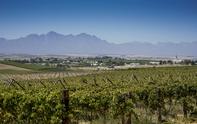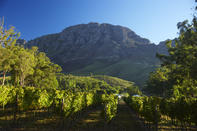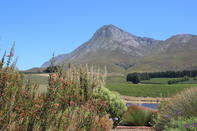The Perfect Wine Region
Almost all of the country’s wine grapes are produced along the coastal zone and some inland areas of the Western Cape, due to its favourable climate and fertile soil. The landscape is characterised by steep, folded mountains that roughly parallels the coast, with lower hills in the Stellenbosch area, and high hill ranges around Durbanville.

The sandstone mountains of Franschhoek and the eastern mountains of Paarl and Wellington have exposed granite intrusions, which is favourable for grape growing. The range of low hills in the Swartland region also produce great grape varietals.
As the old geological formations of the coast have been exposed to long periods of weathering, the soil of the area is perfect for viticulture. The soil contains dominant clay minerals such as iron and aluminium oxides, with an increased acidity, which gives it a unique character suitable for growing grapes for winemaking. The soil of the Breede River Valley contains more free lime than other areas, where vineyards benefit from their low-lying position. Yellow- to reddish-brown soils (oxisols) along mountain foothills in the Constantia area, as well as on ranges of hills in the Malmesbury and Darling areas, are prime wineland regions.
The Mediterranean climate of the Cape benefits the coastal and bordering inland vineyards, creating a hotspot for grape growing. The outstanding varietal character of SA wines can be attributed to the influence of the nearby ocean on temperatures - as the famous saying goes “a vineyard that can see the sea, is a good vineyard”.
The diverse topography and geology of the country’s vineyards contribute to the commercial success of SA’s wine routes, as the numerous wine estates produce top-quality vino with a distinct character and style.
Coastal Winelands

The coastal wine regions relatively near the city centre of Cape Town are all immensely popular amongst locals and tourists alike. The regions are marketed as ‘wine routes’, which is an array of wine estates and wineries that offer family fun in the vineyards.
These regions are blessed with cool ocean breezes and higher altitudes for sweet, tasty grapes that will ultimately be turned into world-class wines. The most commercially successful routes are Constantia in the south, Durbanville to the west and the northern areas of Stellenbosch, Paarl and Franschhoek.
These regions house some of the oldest vineyards in the country, dating back to the late 17th century. Each has its own distinct characteristics: Constantia boasts 5 beautiful wine farms, all blessed with fertile soil on sandstone mountain slopes where wine varieties like Sauvignon Blanc, MCC Brut, Chardonnay and Brut Rosé are produced.
The Franschhoek Wine Valley is known for its high rainfall, permitting the production of some of the country’s most extraordinary Méthode Cap Classiques, Cabernet Sauvignon and Merlot. Paarl produces some of the best white wines of SA, while Stellenbosch keeps it classic with their granite-based soils, producing Pinot Noir, Merlot and Shiraz like no other. Durbanville’s high hill ranges allow for more sun exposure on the grapes, resulting in crisp white wine production.
Other lesser-known gems are the areas of Swartland and Darling, connected by golden wheat fields. The region produces a variety of great wines, and although rainfall is sparse, irrigation ensures that the vineyards are kept in top shape.
Cape South Coast

The South Coast of the Western Cape comprises of a few small pockets of vineyards, blessed with ocean winds, plenty of rainfall and hearty soil that create ideal grape growing conditions.
It is SA’s coolest wine region, with a diverse bouquet of wine producers, specialising in slow-ripening grapes that develop more intense flavours than their hotter-region counterparts. Winelands on the South Coast are ideal tourist destinations for those who want an oceanic experience while sipping a glass of their favourite vino.
The Elgin Valley region has started to make a name for itself in the SA wine industry, producing excellent varieties of red and white wines. It is situated in an inland plateau, surrounded by the ancient Hottentots-Holland Mountains. The natural splendour of the area contributes to its popularity, the vineyards are grown sustainably along the Kogelberg Biosphere.
Bot River, just south of Elgin, is home to an eclectic mix of wineries who focus on conservation, blending ultra-modern winemaking techniques with time-honored processes. The region produces terroir-expressive, cool-climate grape varietals that are perfect for Chenin blanc and Sauvignon blanc.
Heaven on earth meets the cool climate in the Hermanus region. The area is known for producing some of SA’s best Pinot noirs and Chardonnays, focusing on complex red wine blends from vineyards in the Hemel-en-Aarde Valley. The clay soil in which the vineyards grow mimic Northern France conditions.
Further down the coast, the Elim and Napier areas fall within the Cape Agulhas wine district - where the Indian and Atlantic oceans meet. The unique terroir allows for the production of varieties such as Sémillon and Shiraz.